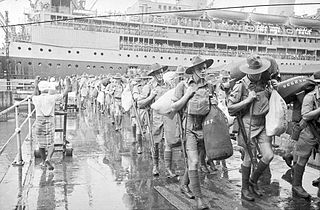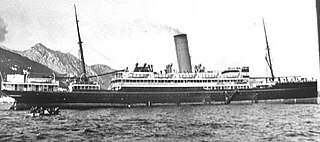Related Research Articles

The 8th Division was an infantry division of the Australian Army, formed during World War II as part of the all-volunteer Second Australian Imperial Force. The 8th Division was raised from volunteers for overseas service from July 1940 onwards. Consisting of three infantry brigades, the intention had been to deploy the division to the Middle East to join the other Australian divisions, but as war with Japan loomed in 1941, the division was divided into four separate forces, which were deployed in different parts of the Asia-Pacific region. All of these formations were destroyed as fighting forces by the end of February 1942 during the fighting for Singapore, and in Rabaul, Ambon, and Timor. Most members of the division became prisoners of war, waiting until the war ended in late 1945 to be liberated. One in three died in captivity.

The Bombing of Darwin, also known as the Battle of Darwin, on 19 February 1942 was the largest single attack ever mounted by a foreign power on Australia. On that day, 242 Japanese aircraft, in two separate raids, attacked the town, ships in Darwin Harbour and the town's two airfields in an attempt to prevent the Allies from using them as bases to contest the invasion of Timor and Java during World War II.

The Battle of Timor occurred in Portuguese Timor and Dutch Timor during the Second World War. Japanese forces invaded the island on 19 February 1942 and were resisted by a small, under-equipped force of Allied military personnel—known as Sparrow Force—predominantly from Australia, United Kingdom, and the Dutch East Indies. Following a brief but stout resistance, the Japanese succeeded in forcing the surrender of the bulk of the Allied force after three days of fighting, although several hundred Australian commandos continued to wage an unconventional raiding campaign. They were resupplied by aircraft and vessels, based mostly in Darwin, Australia, about 650 km (400 mi) to the southeast, across the Timor Sea. During the subsequent fighting, the Japanese suffered heavy casualties, but they were eventually able to contain the Australians.

There was considerable Axis naval activity in Australian waters during the Second World War, despite Australia being remote from the main battlefronts. German and Japanese warships and submarines entered Australian waters between 1940 and 1945 and attacked ships, ports and other targets. Among the best-known attacks are the sinking of HMAS Sydney by a German raider in November 1941, the bombing of Darwin by Japanese naval aircraft in February 1942, and the Japanese midget submarine attack on Sydney Harbour in May 1942. About 40 Allied merchant ships were damaged or sunk off the Australian coast by surface raiders, submarines and mines. Japanese submarines also shelled three Australian ports and submarine-based aircraft flew over several Australian capital cities.

Sparrow Force was a detachment based on the 2/40th Australian Infantry Battalion and other Dutch, British, US and Australian 8th Division units during World War II. The force was formed to defend the island of Timor from invasion by the Empire of Japan. It formed the main part of the Allied units in the Battle of Timor.

Damien Peter Parer was an Australian war photographer. He became famous for his war photography of the Second World War, and was killed by Japanese machine-gun fire at Peleliu, Palau. He was cinematographer for Australia's first Oscar-winning film, Kokoda Front Line!, an edition of the weekly newsreel, Cinesound Review, which was produced by Ken G. Hall.

Australia entered World War II on 3 September 1939, following the government's acceptance of the United Kingdom's declaration of war on Nazi Germany. Australia later entered into a state of war with other members of the Axis powers, including the Kingdom of Italy on 11 June 1940, and the Empire of Japan on 9 December 1941. By the end of the war almost one million Australians had served in the armed forces, whose military units fought primarily in the European theatre, North African campaign, and the South West Pacific theatre. In addition, Australia came under direct attack for the first time in its post-colonial history. Its casualties from enemy action during the war were 27,073 killed and 23,477 wounded. Many more suffered from tropical disease, hunger, and harsh conditions in captivity; of the 21,467 Australian prisoners taken by the Japanese, only 14,000 survived.

SS Zealandia, nicknamed "Z", was an Australian cargo and passenger steamship. She served as a troopship in both World War I and World War II. Zealandia transported the Australian 8th Division. Her crew were the last Allied personnel to see HMAS Sydney, which was lost with all hands in 1941. Zealandia was sunk in the air raids on Darwin of 19 February 1942.

Kokoda Front Line! was a full-length edition of the Australian newsreel, Cinesound Review, produced by the Australian News & Information Bureau and Cinesound Productions Limited in 1942, about the Kokoda Track campaign. It was one of four winners of the 15th Academy Awards for best documentary, and the first Australian film to win an Oscar. It was filmed by the Australian war photographer Damien Parer and directed by Ken G. Hall.

Reginald William Winchester Wilmot was an Australian war correspondent who reported for the BBC and the ABC during the Second World War. After the war he continued to work as a broadcast reporter, and wrote a well-appreciated book about the liberation of Europe. He was killed in the crash of a BOAC Comet over the Mediterranean Sea.

Attacks on continental Australia during World War II were relatively rare due to Australia's geographic position. However, axis surface raiders and submarines periodically attacked shipping in the Australian coastal waters from late 1940 to early 1945. Japanese aircraft bombed towns and airfields in Northern Australia on 97 occasions during 1942 and 1943.. Beginning in January 1942 through to the end of the war, Japan attempted its invasions of the Territory of New Guinea and the Territory of Papua, both of which were under Australian rule at the time.

The 2/2nd Commando Squadron was one of 12 independent companies or commando squadrons raised by the Australian Army for service during World War II. It was initially designated No. 2 Independent Commando Company, and served in Timor, New Guinea and New Britain during World War II, taking part in the Battle of Timor in June 1942 as part of Sparrow Force. Following the capture of the island, the company was withdrawn in December 1942 and returned to Australia, later taking part in operations in New Guinea in 1943–1944 and then on New Britain in 1945.

The 2/40th Battalion was an infantry battalion of the Australian Army. Formed in mid-1940 from personnel recruited from Tasmania, the battalion was assigned to the 23rd Brigade, which formed part of the 8th Division. After completing basic training, the 2/40th was sent to Darwin to form part of the defensive garrison there as tensions with the Japanese grew throughout 1941. Following Japan's entry into the war, the battalion was deployed to Timor as part of Sparrow Force and in early 1942 they took part in the fighting on the island against the Japanese. Outnumbered and lacking supplies, the majority of the 2/40th's personnel were captured and spent the rest of the war as prisoners of war, although some were able to wage a guerrilla campaign across the island before being withdrawn by the end of year.
100,000 Cobbers is a 1942 dramatised documentary made by director Ken G. Hall for the Australian Department of Information during World War II to boost recruitment into the armed forces. Grant Taylor, Joe Valli and Shirley Ann Richards play fictitious characters.
South West Pacific is a 1943 propaganda short Australian film directed by Ken G. Hall which focuses on Australia as the main Allied base in the South West Pacific area. Actors depict a cross section of Australians involved in the war effort.

Winnie the War Winner was a radio set built by Sparrow Force during the Battle of Timor in 1942. The radio re-established contact between Sparrow Force and the Australian Army in Darwin on 19 April 1942. At the time, the Allies believed that Sparrow Force had been captured by the Japanese Army. By then, Sparrow Force had fought a guerrilla campaign isolated from Australia for 60 days.
Assault on Salamaua is a 1943 Australian documentary film, produced by Cinesound Productions, about the Salamaua–Lae campaign during World War II.
Bismark Convoy Smashed!, also known as Battle of the Bismark Sea, is a Second World War 1943 Australian documentary newsreel film about the Battle of the Bismarck Sea on 2–3 March, an engagement which resulted in the claimed destruction of 22 Japanese ships, their crews and 15,000 soldiers. Actual Japanese losses were rather less, but still devastating.
The Road to Kokoda is a 1942 Australian documentary. Much of the footage shot by Australian war photographer Damien Parer (1912–1944) also appears in Kokoda Front Line!.

The Western Australian emergency of March 1942 was a series of local responses that occurred in relation to activity in northern Western Australia that gave Australian military forces serious concerns about the capacity of the Japanese to move down the Western Australian coast.
Singapore fell on 15 February 1942 with more than 50,000 men becoming prisoners of war, including the WA raised 2/4 Machine Gun Battalion. Darwin was bombed on 19 February by the same Japanese fleet that had attacked Pearl Harbour. On 3 March, Broome was attacked from the air, killing many refugees from the Netherlands East Indies which had now been captured along with the Philippines.
References
- ↑ "Men of Timor" at WW2 Australia
- ↑ "PARER FILMS COMMANDO ACTIVITIES IN TIMOR". Daily Mercury . Mackay, Qld. 7 January 1943. p. 5. Retrieved 18 April 2015– via National Library of Australia.
- ↑ "Advertising". The Sydney Morning Herald . 4 January 1943. p. 2. Retrieved 18 April 2015– via National Library of Australia.